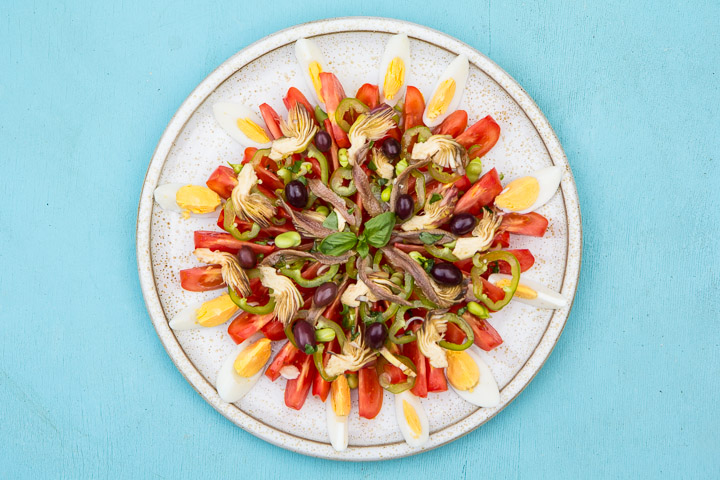
« Nice - Le port Lympia » par Qjafcc — Travail personnel. Sous licence CC BY-SA 3.0 via Wikimedia Commons.
 « Socca a Nice » par Myrabella — Travail personnel. Sous licence CC BY-SA 3.0 via Wikimedia Commons.
« Socca a Nice » par Myrabella — Travail personnel. Sous licence CC BY-SA 3.0 via Wikimedia Commons. Salade Niçoise is a dish that does not have an official recipe and as such tends to cause controversy. There are many schools of thought as to what should be in a Salade Niçoise, but let’s just mention the two most famous, Jacques Médecin, a former mayor of Nice and Auguste Escoffier, a famous cook who puts green beans and boiled potatoes—sacrilege!
Salade Niçoise is a dish that does not have an official recipe and as such tends to cause controversy. There are many schools of thought as to what should be in a Salade Niçoise, but let’s just mention the two most famous, Jacques Médecin, a former mayor of Nice and Auguste Escoffier, a famous cook who puts green beans and boiled potatoes—sacrilege! The original Salade Niçoise was a dish for the poor, it had 3 ingredients: • Tomatoes • Anchovies • Olive oil The modern version has : • Tomatoes • Beans and / or artichokes • spring onions or radishes • Capsicum • Basil • Canned tuna or anchovies • Hard-boiled eggs • Olives • Olive oil and red wine vinegar • Garlic • Salt and pepper It’s delicious and reminds me of wonderful times I had in Nice and Grasse, where my grandma had a Mas Provençal. If you want to know more, this article is excellent : http://www.lemanger.fr/index.php/salade-nicoise-vraie/ |  La Salade Niçoise est un plat qui n’a pas de recette officielle et a tendance à provoquer la controverse. Il existe de nombreuses écoles de pensée quant à ce qui devrait être dans une salade niçoise, mais nous allons juste mentionner les deux plus célèbres, Jacques Médecin, ancien maire de Nice et Auguste Escoffier, un cuisinier célèbre qui met les haricots verts et pommes de terre-sacrilège!
La Salade Niçoise est un plat qui n’a pas de recette officielle et a tendance à provoquer la controverse. Il existe de nombreuses écoles de pensée quant à ce qui devrait être dans une salade niçoise, mais nous allons juste mentionner les deux plus célèbres, Jacques Médecin, ancien maire de Nice et Auguste Escoffier, un cuisinier célèbre qui met les haricots verts et pommes de terre-sacrilège! A l’origine, la salade niçoise était un plat pour les pauvres, il y avait 3 ingrédients: • Tomate • Anchois • Huile d’olive et basta. La version moderne a: • Tomates • Fèves et/ou artichauts • Cébettes ou radis • Poivrons salade • Basilic • Anchois ou thon en conserve • Oeufs durs • Olives de Nice • Huile d’olive et vinaigre de vin rouge • Ail • Sel, poivre C'est délicieux et me rappelle de merveilleux moments que j'ai eus à Nice et Grasse, où ma grand-mère avait un Mas Provençal. Si vous voulez en savoir plus, cet article est excellent: http://www.lemanger.fr/index.php/salade-nicoise-vraie/ |
 |
|
© Camille Oger
|
 If you put all that in a sandwich, it’s called a Pan Bagnat
If you put all that in a sandwich, it’s called a Pan Bagnat |  Si vous mettez tout cela dans un sandwich, ça s'appelle un Pan bagnat
Si vous mettez tout cela dans un sandwich, ça s'appelle un Pan bagnat
|
« Panbagnat » par Mirasol — Travail personnel. Sous licence CC BY-SA 3.0 via Wikimedia Commons.












